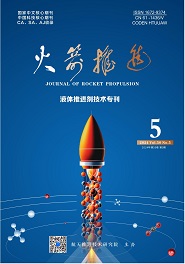航天推进技术研究院主办
GAO Xiang-yu,SUN Ji-guo,TIAN Yuan.Numerical analysis of H2 transpiration cooling for thrust chamber porous plate[J].Journal of Rocket Propulsion,2012,38(05):13-17.
推力室多孔面板氢发汗冷却传热分析
- Title:
- Numerical analysis of H2 transpiration cooling for thrust chamber porous plate
- 文章编号:
- 1672-9374(2012)05-0013-05
- 分类号:
- V434+.14
- 文献标志码:
- A
- 摘要:
- 为了研究氢氧火箭发动机推力室喷注器多孔面板的发汗冷却特性,采用一维非热平衡能量方程模型对其进行了数值传热计算,计算模型考虑了冷却剂氢的变物性和多孔结构内固体与流体之间的对流换特征。分析总结了多孔结构固体导热率、孔隙率、颗粒特征直径和燃烧室热流密度等因素对多孔面板发汗冷却的影响。研究结果表明,选择较高导热率的多孔面板制造材料能够降低燃气侧面板温度和减小面板温度梯度;孔隙率一般在0.1~0.2为宜;随着颗粒特征直径增大冷却剂与多孔结构固体之间的换热能力明显下降,燃气侧面板温度呈先降低后升高的趋势。
- Abstract:
- In order to investigate the transpiration cooling characteristics of H/O rocket engine thrust chamber injector porous plate, the one-dimensional local thermal non-equilibrium numerical model was adopted to conduct the heat transfer computation and analysis. The hydrogen coolant thermo-physical properties varied with both temperature and pressure, and heat transfer between the porous media and coolant were considered for the computation model. The influence of porous media thermal conductivity, porosity, sphere diameter and heat flow density on porous plate transpiration cooling were analyzed. The investigation demonstrates that optimization of porous plate material with high thermal conductivity can reduce the gas side plate temperature and temperature gradient of porous plate. The porosity should be 0.1~0.2. The heat transfer capacity between the porous media and coolant is obviously reduced with the increase of sphere diameter, but the temperature of the gas side plate decreases at first and then increases.
参考文献/References:
[1]HUDSON L, STEPHENS C. The X-37 hot structure control surface testing[R]. USA: NASA 2006.
[2]BUCCHI A, BRUNO C. Transpiration cooling performance in LOX/Methane liquid-fuel rocket engines[J]. Journal of Spacecraft and Rockets, 2005, 42(3): 50-59.
[3]BUCCHI A, CONGIUNTI A, BRUNO Claudio. Investigation of transpiration cooling performance in LOX/Methane liquid rocket engines[J]. IAC, 2003 (10): 22-26.
[4]刘双, 张博明, 解维华. 可重复使用航天器金属热防护系统的结构优化进展[J]. 航天制造技术, 2007 (3): 43-48.
[5]EMRE S, WEI S. Modeling of fluid dynamics and heat transfer through porous media for liquid rocket propulsion, AIAA 2007-5549 [R]. USA: AIAA, 2007.
[6]于淼, 姜培学. 发汗冷却过程中多孔壁面内的局部非热平衡分析[J]. 工程热物理学报, 2007, 28(2): 286-288.
[7]JIANG Pei-xue, REN Ze-pei. Numerical investigation of forced convection heat transfer in porous media using a thermal non-equilibrium model[J]. International Journal of Heat and Fluid Flow, 2001, 22(1): 102-110.
[8]高翔宇, 孙纪国. 推力室多孔面板发汗冷却试验研究[J]. 火箭推进, 2011, 37(5): 9-12.
[9]ACHENBACH E. Heat and flow characteristics of packed beds[J]. Experimental Thermal and Fluid Science, 1995, 10(1):17-27.
[10]DIXON A G, GRESSWELL D L. Theoretical prediction of effective heat transfer parameters in packed beds[J]. AICHE J., 1979, 25(4): 663-676.
[11]VAFAI K, AMIRI A. Non-Darcian effects in confined forced convective flows[J]. Numerical Heat Transfer Journal Part A, 1997, 31: 235-254.
[12]孙纪国, 王建华. 烧结多孔结构的渗透和流阻特性研究[J]. 航空动力学报, 2008, 23(1): 130-133.
[13]DUKHAN N, PATEL P. Equivalent particle diameter and length scale for pressure drop in porous metals[J]. Expe- rimental Thermal and Fluid Science, 2008, 32(5): 1059-1067.
[14]MCCARTY R. Hydrogen technology survey thermo physi- cal properties, NASA SP-3089[R]. USA: NASA, 1975.
相似文献/References:
[1]张 倩,王 兵,张耘隆,等.超音速混合层着火距离的一种理论预测方法[J].火箭推进,2015,41(01):50.
ZHANG Qian,WANG Bing,ZHANG Yun-long,et al.A theoretical prediction method of ignition
distance in supersonic mixing layer[J].Journal of Rocket Propulsion,2015,41(05):50.
[2]黄春桃,孙 冰.层板发汗冷却推力室传热分析[J].火箭推进,2011,37(01):17.
HUANG Chun-tao,SUN Bing.Heat transfer analysis of platelet transpiration cooling thrust chamber[J].Journal of Rocket Propulsion,2011,37(05):17.
[3]高翔宇,孙纪国.推力室多孔面板发汗冷却试验研究[J].火箭推进,2011,37(05):9.
GAO Xiang-yu,SUN Ji-guo.Experimental study on porous plate transpiration cooling of thrust chamber[J].Journal of Rocket Propulsion,2011,37(05):9.
[4]王飞,周前红,郭少峰,等.电弧推力器流场的数值计算[J].火箭推进,2010,36(02):2.
Wang Fei,Zhou Qianhong,Guo Shaofeng,et al.Numerical calculation of flow field of arcjet[J].Journal of Rocket Propulsion,2010,36(05):2.
[5]张峰,刘伟强.层板发汗冷却在液体火箭发动机中的应用与发展综述[J].火箭推进,2007,33(06):43.
Zhang Feng,Liu Weiqiang.Application and development of platelet transpiration cooling technology in LRE[J].Journal of Rocket Propulsion,2007,33(05):43.
备注/Memo
收稿日期:2012-05-21;修回日期:2012-08-06
基金项目:国家863项目(2009AA7020512)
作者简介:高翔宇(1981—),男,工程师,研究领域为液体火箭发动机传热技术
